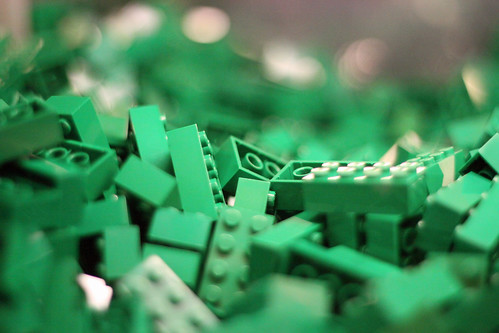LEGO has played a small role in a debate over evolution, intelligent design and the role of religion in the classroom. John Freshwater was a middle school science teacher in Ohio until he was fired for a number of violations involving inappropriate use of religion in the classroom, teaching of ID and abusive treatment of students. In one of the various hearings and lawsuits, he testified about whether he used a
thought experiment involving LEGO. It goes like this - if you shake up a box of blocks, a completed model is not going to suddenly appear. Therefore, he argues, you can't expect complex order to come from disorder.
Speaking as someone who is both a scientist and religious, this is incredibly simple-minded. The real ID thinkers are much more sophisticated than this and should be met on those grounds, rather than some (alleged) abusive jerk who doesn't seem to know much either science or religion. Oh well, at least it was an interesting LEGO reference.

(image of LEGO bricks by TravelingRoths)

Freshwater was never actually fired—what the board did was to start the process of firing him and place him on unpaid administrative leave. The June 2008 resolution by Mount Vernon Board of Education was titled “Intent to consider the termination of the teaching contract(s) of John Freshwater.”
ReplyDeleteI attended the hearing in which the subject of the LEGO brick demonstration was brought up. Freshwater testified that it was a student who performed the demonstration in his class. (See my article “Missing Evidence in John Freshwater Hearing” the section titled “LEGO bricks.”)
http://www.accountabilityinthemedia.com/2010/01/john-freshwater-hearing-missing.html
In one of the various hearings and lawsuits, he testified about whether he used a thought experiment involving LEGO.
ReplyDeleteIt was an actual demonstration, not a thought experiment.
And contrary to what Sam posted, in his testimony Freshwater slid around the question of his having used it in class. However, in a radio interview (see my transcription of the interview here, Freshwater said that "A student showed me many years ago, and I used it up until 2003, ...".
(I should mention that I also attended the hearing that day.)
ReplyDeleteInterestingly, the analogy doesn't hold up - I've actually discovered quite a few ideas just by looking at the ways parts have stuck themselves together just by being rattled around. A completed model isn't likely to appear after a short amount of shaking, but unique clumps can (and do) occur occasionally.
ReplyDeleteHey guys,
ReplyDeleteThanks for the additional information. I probably should have researched a little more deeply before posting - I was just kind of excited to find a reference to LEGO in an article relating to a topic relevant to this blog.
Bruce